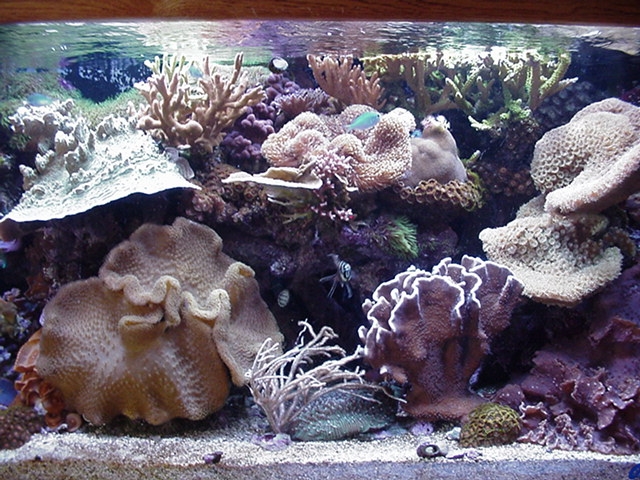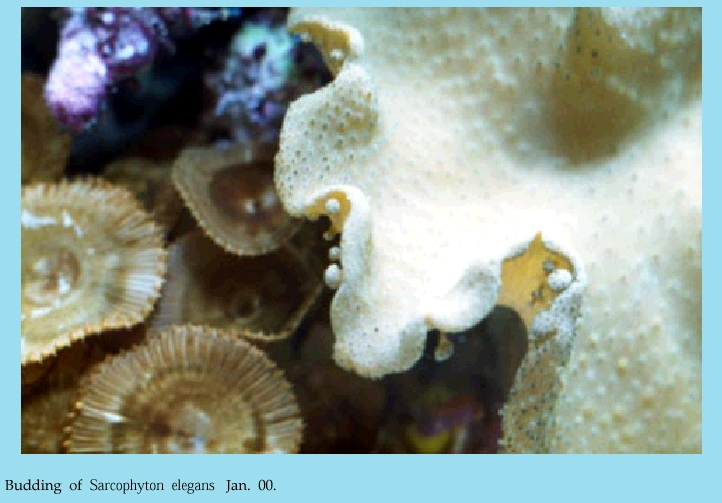
By Bob Goemans

The recent budding of two corals in my 125 gallon plenum-equipped reef system may be the first recording of its kind.
A Yellow Leather coral, Sarcophyton elegans, was purchased in a local shop about five years ago. These corals are usually imported from Tonga or Fiji and often do not ship well. Purchasing one locally guaranteed getting one that didn’t have dark decaying areas due to injuries received in collection or shipping. Since they don’t seem to be as hardy as other Sarcophyton species and they are more expensive, it’s best to get a very healthy specimen the first time.
This coral was part of my first 75 gallon plenum system and was about 2 inches across when purchased. It was moved to larger quarters, the 125 gallon system noted above, about three years ago. It was placed so it received mostly indirect, yet strong light. Water quality has always been excellent - never any indications of ammonia, nitrite, or nitrate. The pH remains at natural seawater parameters of 8.1 – 8.2. The system is equipped with a large and efficient Marine Technical Concepts (1) protein skimmer (HSA 1000) and has used either the Korallin 3000 (2) or Marine Technical Concepts Pro-Cal calcium reactor over the past few years.
Alkalinity is always in the 10 – 14 dKH range, magnesium is maintained at or near 1300 mg/l, calcium is always about 430 mg/l, and iodide is occasionally used. Instant Ocean (3) has almost always been the salt mix of choice. The only additive used on a constant basis is Marc Weiss Reef-Vital DNA and more recently, Spectra-Vital (4).
Light is provided by two Energy Savers (5) 250 watt, 10K metal halides and two thirty watt 50/50 fluorescent lamps. The system’s fluorescent lamps come on at 8 AM. The metal halides come on at 9 AM and go off at 6 PM. The fluorescent lamps go off at 10:30 PM. About 6 weeks ago, BrightLights Technologies (6) sent me a pre-production model of their new moonlight called the MoonStrip. It’s comes on a little before the fluorescent lamps go out and shuts off about sunrise.
Water movement is controlled by a wavemaker and the system experiences ocassional surges up to 2000 gallons per hour Evaporation makeup is automatically controlled using a buffered solution of RO/DI water. I say buffered because the water used in my reservoir comes from a large vat on my back porch that has about 4 inches of weekly stirred CaribSea (7) aragonite gravel on its bottom. That’s enough aragonite to bring its 40 gallons of RO/DI water, which has an original pH of 6.5, back to a pH of 8.4 and add about 150 mg/l of calcium.
Recently, while accomplishing some regular maintenance, I disturbed this large Sarcophyton elegans while wiping the aquariums front panel. As you can see it is now about 14 inches across and is near the front of the tank. It reacted to being touched and became somewhat smaller. It was then I noticed about two dozen protruding polyp-like growths, each with numerous small polyps hanging off the backside of the animal. 
This may be first recording of such a happening with this coral! In fact, this specimen has now grown into two, almost separate organisms. As you can see in the photo, its mushroom-shaped head now forms almost two separate heads. It’s only joined by one small area of tissue in the area between the two heads. I could take a knife and separate them, but way fool with Mother Nature if it’s not necessary. As soon as I have a new supply of Super Reef Gel (8) I’ll remove a few polyp-like growths and cement them in appropriately lit areas. It should be quite interesting to observe their growth rates.
A second coral, commonly called Chalice or Cup Coral, Turbinaria peltata, has also grow quite large and is visible on the right side of the photo. A large number of bump-like growths are forming on its underside along the lower circumference of the animal. Even though no direct light reaches this area, what will develop from these numerous small bump-like growths is yet a mystery.
If there are any other known and documented cases of these type happenings with these particular corals, I would be interested in knowing about it.
References
1) Marine Technical Concepts, Inc., 225 Godwin Ave., P.O. Box 297, Midland Park, NJ 07432, (201) 444-7165, FAX (201) 444-5825, www.marinetechnical.com.
2) Monolith Marine Monsters, Four Canal Park, Suite 508, Cambridge, MA 02141, (617) 494-8396, fax (617) 494-8396, www.marine-monsters.com.
3) Aquarium Systems, Inc., 8141 Tyler Blvd., Mentor, OH 44060, (800) 822-1100, www.aquariumsystems.com.
4) Marc Weiss & Co., 5935 Ravenswood Road, E20, Ft. Lauderdale, FL 33312, (954) 894-9222, Fax (954) 894-9226.
5) Energy Savers Unlimited, 910 East Sandhill Ave., Carson, CA 90746 1-(800) 678-8844, (310) 851-8999, FAX (310) 851-8996, www.esuweb.com.
6) BrightLights Technologies, 47517 Putney Court, Canton, MI 48188
(734) 495-0095, fax (734) 495-3586.
7) CaribSea Inc., P.O. Box 570269, Miami, FL 33157, (561) 461-1113, fax (561) 461-1986.
8) Super Reef Gel, C/O Mark Barnes, 1542 Independence, Boise, ID 83706, (208) 345-8798.